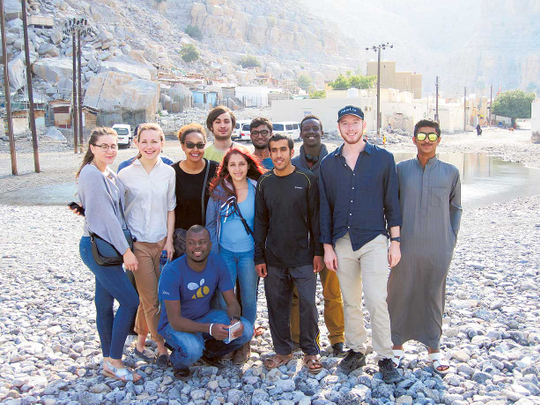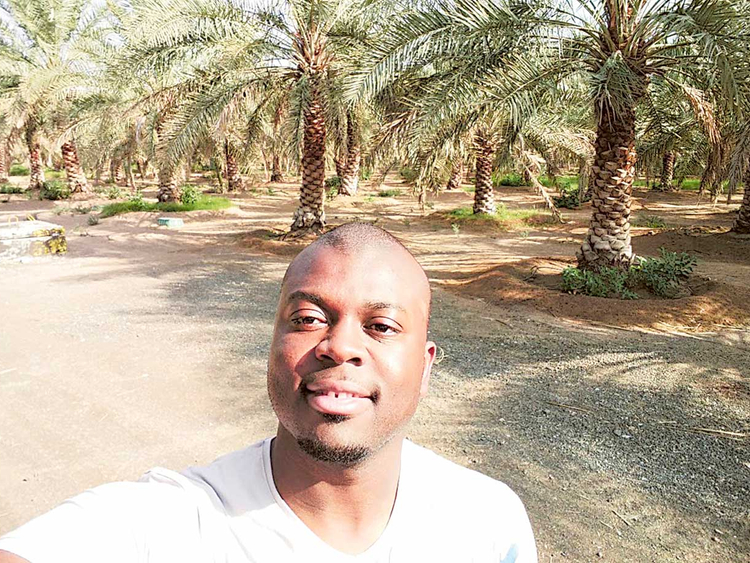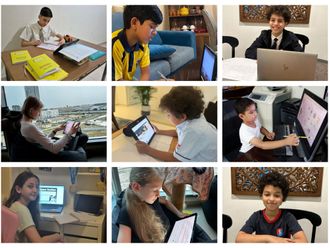
Abu Dhabi: Usually when students are taught about the distinguishing features of a desert country such as the UAE, mountains and long, beautiful stretches of coastline are not the kind of descriptions that crop up. But this notion is exactly what visiting professors from abroad are challenging as they take classes in the UAE and urge students to step out and participate in outdoor classrooms as well.
The New York University Abu Dhabi, as part of its J-term study programme, offers courses that are intended to make students explore the outdoors in the UAE in order for them to have a better understanding of the region.
J-term or January Term classes combine theory and experiential learning for students in a way that marks a big departure from classes during others semesters. The shared experiences between professors and students forges an unusually strong bond between them.
The main goal was to provide students with an exposure to the region that they might not have received from their classes or personal travels. To achieve this aim, the course focused on three distinct landscapes — desert oases principally in Al Ain, the coasts of Dubai, Ras Al Khaimah, and Musandam, and the Jabal Al Akhdhar Mountain in Oman, the professors said.
The students led by Dr Steven Canton from the Centre of Middle Eastern Studies at Harvard University, and Dr Donald Scott, an expert on comparative history, visited a number of different sites in the region, conducting their lessons on site. The students thus experienced a new way of integrating knowledge and a sense of place, aspects that are crucial to comprehending history, heritage or even contemporary events.
“The other goal was to get students to carefully observe sites in these three landscapes and describe what they observed in daily field notes. While on site, they took quick scratch notes and, as soon as was possible after their visit, they would write a 1-2 page narrative… At the end of their travels, they were asked to reflect on the themes that came up in their notes that intrigued them and to explain why,” Dr Canton added.
As part of the experience, the students along with the professors, also visited local villages and people, immersing themselves into their customs and traditions.
“In the mountains, we took several walks along well-worn paths to visit different villages. In one village, we learned how to cook a meal, using local ingredients. In another, we helped to clear a farm plot of dead growth, using conventional implements, and then prepared it for falaj irrigation,” Dr Scott said.
“In the process, we learned about what crops were grown and how valuable they were, the stresses that such agriculture poses on water resources, and how mountain farmers are adapting by building green houses, where they grow tomatoes, peppers, and zucchini under controlled environmental conditions,” he added.
The course did not come without its set of challenges.
“The days were long, often ten hours or more and taxing, especially when the demand was to pay attention and be active in the learning process; and at the end of the day, there often was a class discussion and, of course, the constant note taking. There were no days off either, given the number of landscapes we wanted to cover in two and a half weeks,” Dr Canton said.
Despite the challenges, both professors said they are happy that they were able to contribute another dimension to the process of assimilating knowledge of the region and aid interaction between the local people and their surroundings.
“To most people who’ve never been to the region, it is [usually thought to be only] about deserts, oases, and the Bedouin. If they’re shown a satellite map of the Arabian Peninsula however, they will almost always notice that it’s surrounded by seas on three sides and that it has a huge coastline. Suddenly, a light bulb goes on. The coasts may be as important, if not more important, than the desert,” said Dr Scott.
“And if you then point out to them the Hajjar mountain range and ask them if they had thought of the region as a mountainous landscape, they are surprised to learn about the height and the ruggedness [of the range].
“The idea that people retreated to them from the coasts in the hot and humid summer months is not the least bit surprising, if also never considered by them before. And once they see the intricate terracing along the sides of the mountains, they have a whole new respect for and understanding of what agriculture means historically in the region,” he added.
Joe Jean, a student from Haiti, who took part in the course, said he was grateful for the opportunity as it allowed him to experience new things.
“This course made me realise that the UAE is more than just desert, it also has beautiful oases, from small farms to huge organic farms, and a brilliant traditional irrigation system… I would totally encourage everyone who has the chance to explore the Arabian Gulf landscape. It is absolutely beautiful,” he said.
According to Jean, the educational process was a mix of lectures and onsite observations for students.
“Usually before visiting a site, we would either read some papers about it or our professor would give us a lecture to help us understand the historical, cultural importance of the site. On site, a guide usually would give us an overview and followed by a question-and-answer session,” he said.
Being able to meet and interact with the people was also a highlight for Jean. “One thing that really stood out for me was the hospitality and the generosity of the Emirati and Omani people. They made me feel truly at home. And for that I want to say ‘thank you’,” he said.













